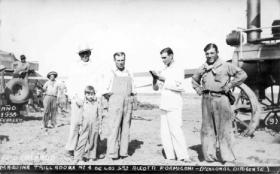From tenant farmers to landlords
Published in 18th–19th - Century History, Features, Issue 4 (Jul/Aug 2008), Volume 16
Wheat-threshing at the Youngs ranch in Orlando, February 1938. Irish-Argentinian landowners such as the Youngs hired contractors like Aleotti Formigoni (right), who owned the steam-powered threshing machine. (Centro Argentino Irlandés de San Pedro)
The most flourishing Irish rural settlements in the region grew up in the Argentine and Uruguayan Pampas. The successful integration of the immigrants into the wool production cycle was followed by spontaneous networks attracting family members, neighbours and friends from Ireland. Between 1830 and 1930 about 50,000 emigrants went to Argentina. One half returned to Ireland or re-emigrated to other places, but the other half formed the Irish-Argentine community. The success ratio of the latter group, measured by access to landownership, was disproportionate compared to the Irish diaspora in other destinations (though French-Basque and Catalonian immigrants in Argentina in the same period were equally successful).
Most of the emigrants were the sons (and later the daughters) of middle-sized farmers from Westmeath, Longford, Offaly and Wexford, though there were smaller groups from Dublin, Cork and Clare. They nurtured the dream of owning 2,000 hectares in South America instead of being tenants of 20 hectares in Ireland. In the Pampas they were hired by ranchers to look after their sheep, and some managed to acquire land thanks to the increase in wool prices between 1830 and 1880, together with convenient agreements for half or third of the produce in wool and lambs. A few purchased large tracts of land from the government in areas gained from the indigenous peoples. The vast majority, however, were ranch hands and labourers, and could never purchase land. Stories circulated in Ireland of poor emigrants who became wealthy landowners in South America. These stories, frequently exaggerated, were sometimes fuelled by those who failed to settle successfully in Argentina but could not admit to failure back home.


















